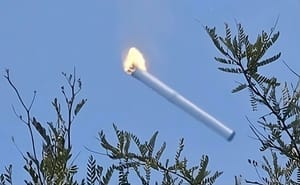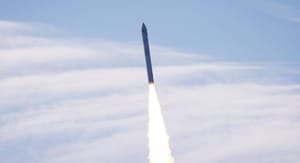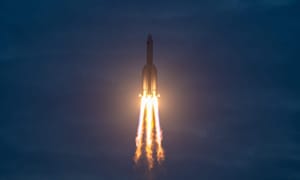
Unexpected Liftoff - Space Pioneer's static fire incident
Disclaimer: This article contains the speculation of the writers due to the ongoing accident investigation by Space Pioneer and authorities in China.
Space Pioneer has recently become a well-known name in China's commercial aerospace industry, but for the wrong reasons. The company escalated to the spotlight outside of China after its new launch vehicle failed catastrophically during a static fire.
What happened?
Space Pioneer's Tianlong-3 rocket was progressing very smoothly for a 2024 debut. The first stage was spotted several times, all nine engines were tested beforehand, and the first stage was successfully integrated on the test stand. The test stand was a modified Tianlong-2 test stand, the company's smaller rocket, located inside a former quarry.

This test was supposed to be a simple static fire, but at 7:43 UTC on June 30th, the nine Tianhuo-12 engines worked as expected, reaching 820 tons of thrust. However, the stage escaped from its mounts and flew away.

Its accidental flight ended after just 50 seconds when the Tianlong-3 crashed into a hilly area near Gongyi, initially presumed to be Qinglong Mountain and appearing to be within those ranges, creating a massive fireball that some onlookers caught on video.
After lifting off the computer on the rocket shut down after wire connections were severed between the pad and the booster. The rocket crashed deep into a mountain 1.5 kilometers southwest of the test site, satellite imagery places this at approximately 1,470 meters away.
“Before the test, we worked with the local government to improve safety measures and organised the evacuation of people in surrounding areas in advance. After investigations, there were no casualties,” Space Pioneer reported
Local news outlets also interviewed local village residents who were relocated to a nearby village for the test. They lived around a mile away from the launch site. While people up to 5 kilometers away from the crash site caught it on video. No casualties were reported after response teams were dispatched.
Space Pioneer's response at first was met with criticism in regards to how it was handled, mentioning the distance from Gongyi, and then boasting about the Tianlong-3's capability.
“It was apparently not far from the densely populated area of Gongyi, and the rocket was out of control,” one Weibo user wrote.
“However, the company did not even call it an accident in their statement. Instead, they were busy talking about the rocket parameters.”
Space Pioneer then responded with a formal apology, two days later, to the residents nearby and to the city of Gongyi. All damages to people's houses are currently being assessed according to the company. They also stated they would compensate for people's losses, according to the statement.
What caused this?
Based on imagery of the stand afterward, views of the stage during flight, and patents for the stand, it is likely that Space Pioneer did not accurately account for the weight of the rocket and the total potential thrust, given that it lifted off mere seconds after ignition. The stand itself was rated to hold down a vehicle producing up to 600 tons of thrust.
Space Pioneer has not disclosed how much propellant was loaded into the test stage, but estimates of remaining fuel, based on the explosion, place it at between 220-300 tons at the time of impact. The company also did not say if they fully loaded just one or both tanks to try and hold down the stage. As an example, SpaceX loads extra 'ballast' liquid oxygen into its Super Heavy boosters during static fires, and only the liquid methane needed to perform the necessary tests.

Space Pioneer has said that the rocket broke free due to a structural failure, but did not say what part of the stand or vehicle. Based on images of the aftermath and during the production of the vehicle, it appears that the part of the engine section where hold-down bolts were attached ripped apart from the rest of the vehicle upon it reaching a high enough thrust. The connections to the stand at the base of the stage are also the only structural connections that were planned to keep it in place, compared to SpaceX's Falcon 9 static fire stands that secure boosters at the base and top of the stage.
Immediate Impact?
With the loss of this specific first-stage the maiden flight scheduled for September of this year is likely delayed toward later this year, or pushed into 2025. Two more first-stages are believed to be in production, along with their engines, but their production status is unknown.
Static fire tests are expected to no longer be performed at Space Pioneer's Gongyi test site and will likely move to the company's launch pad at the Jiuquan Satellite Launch Center, which is still under construction. Individual tests are still expected to occur at Gongyi, due to the more mature test stands for single engines.
Long-Term Problems?
This accident may have deterred potential future investors away from Space Pioneer. Some of the company's prior investors may also now be less willing to provide greater investment, or be looking to remove their investment. Depending on the attitude of Space Pioneer's investors, this could be a significant problem for the company's long-term visions.
Trouble could also be ahead for Space Pioneer depending on the outcome of an accident investigation into the incident. Law in China dictates that a company can be fined for accidents that cause "personal injury, death or direct economic losses in production and business activities", if the local government decides that this was a production accident. At best this could see Space Pioneer fined for an amount equal to 30% of last year's income, possibly including investment, and 80% at worst. 2023 saw the company bring in a believed 700 million Yuan Renminbi, or 95 million United States Dollars, in investor funding.
Ahead of an anticipated rise in launch activity in coming years, China's central government offices and officials may also use the recent accident to push through new regulations to further govern the commercial space sector. The central government notably cracked down on growing risks in the tech sector in recent years over the span of thirty-two months.
Who is Space Pioneer?
Space Pioneer is a privately owned commercial launch company, providing launch services to China's satellite manufacturers, and is headquartered in Beijing. The company was founded in 2019 by Kang Yonglai, the company's current Chief Executive Officer.
As of the end of June 2024, the company has raised 4 billion Yuan Renminbi, approximately 552 million United States Dollars, through fifteen funding rounds. So far the company has made it to orbit once, with its Tianlong-2 launch vehicle in April of 2023.




